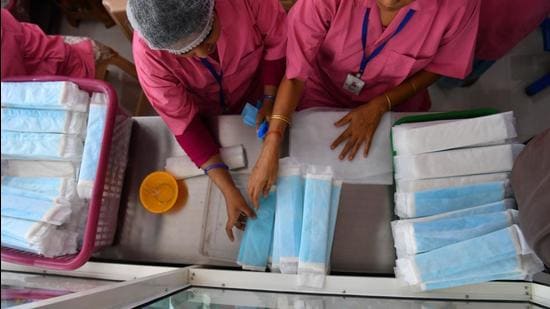A case for environment-friendly sanitary pads
There is an urgent need for course correction through effective policy interventions. The government must create a gender-inclusive platform for continuous dialogue and consultation on key issues with experts and civil society organisations
The Centre has introduced a scheme for the promotion of menstrual hygiene among adolescent girls in the age group of 10-19 years old in the rural areas. The objective is to increase the use of high-quality sanitary napkins and ensure their safe disposal. The scheme was initially implemented in 2011 wherein a pack of six sanitary napkins called “Freedays” was provided to rural adolescent girls.

From 2014, funds are being provided to states/Union Territories under the National Health Mission for the decentralised procurement of sanitary napkins packs for provision to rural adolescent girls at a subsidised rate of ₹1 for a pad.
Considering that less than 50% of women in the target group are using sanitary napkins, the efforts of governments to promote the use of sanitary napkins are commendable. According to the Menstrual Health Alliance of India, the country has 336 million menstruating women, of which only 121 million or 32% use sanitary pads.
It was only after Purnima Khandelwal, founder of Plastic-Free Period Campaign and a feisty sustainable menstruation crusader, drew my attention to the obverse side of the problem, did I realise the environmental consequences of this policy.
The sanitary pads commonly used by women from all classes contain super-absorbent polymers (SAP), which don’t decompose. They gradually break down into what are known as micro-plastics, which contaminate soil, water and air. They also enter the food chain injecting toxins into the food humans and animals consume. Two of the ingredients used in commercial non-biodegradable menstrual napkins also have serious health consequences for women. These are dioxins that are used to bleach the absorbent core and responsible for side-effects in the body such as pelvic inflammatory disease, ovarian cancer, immune system damage, impaired fertility and diabetes.
Now imagine if the number of menstruating women who use commercial sanitary pads containing plastics is doubled, taking it to 242 million (still far short of universal coverage). This would increase the number of sanitary pads requiring disposal, in some form, to 24 billion annually. Whereas in the urban areas, these mostly reach landfills, in the rural areas, these would are either burnt or buried in some form of pits, the two methods recommended in the guidelines issued by the Government of India for the promotion of menstrual hygiene. The ecological damage caused by this will have far-reaching consequences and the government may have to spend much more in cleaning up the mess their short-sightedness in pushing the use of plastic containing sanitary napkins would create. A single commercial sanitary napkin takes 500-800 years to decompose. On an average, a woman could use up to 10,000 sanitary pads from menarche to menopause.
A 2017 report by Euromonitor, a market research company, revealed that the Indian feminine hygiene product market was valued at $340 million and was expected to reach $522 million by 2020. As the use of sanitary pads increases rapidly, the value of the product market would also rise substantially. But, at present, there is no incentive to point the market towards environment- and health- friendly bio-degradable sanitary pads.
Although several non-governmental organisations (NGOs) have been producing such products through women self-help groups (SHGs), it is not to scale. Network units producing and marketing at commercial scale are not inclined to invest in research and development (R&D) for more cost-effective and environment-friendly sanitary pads. Government purchases, in very large quantities, mostly from network units, are pushing them to scale up their production capacities — but of pads containing plastic.
Mass education as part of the menstrual hygiene programme has produced some widely accepted but flawed assumptions — that the use of cloth, as has traditionally been done, is unhygienic; the use of sanitary pads offers hygienic means for managing menstruation under all conditions; all types of sanitary pads available in the market are safe for use; and menstrual waste generated through sanitary pads is efficiently managed through current waste management infrastructure.
These assumptions can easily be challenged. For instance, with proper training on cleaning, washing and drying, cloth pads are safer than commercial pads. It is also not true that the current solid waste management system, which is extremely poorly managed in the urban centres and is virtually non-existent in rural areas, is adequately addressing the issue of menstrual waste disposal.
There is an urgent need for course correction through effective policy interventions. The government must create a gender-inclusive platform for continuous dialogue and consultation on key issues with experts and civil society organisations and find sustainable and effective alternatives to pads containing plastics. It is also important to correct the incentive system to nudge the market towards affordable biodegradable and reusable pads.
As a start, central and state governments must announce that from April 1, 2023, purchases they make shall exclude pads containing plastics. This will allow network manufacturers and others to plan their production lines in accordance with the timelines.
A special “disposal cess” should be imposed from FY2023 on pads containing plastic to penalise producers and make them pay for scientific disposal of the pads. The government should also amend the existing frameworks under the Swachh Bharat Mission to provide for detailed guidelines for appropriate disposal methods to remove ambiguity. SHGs, under National Urban Livelihood Mission (NULM) and National Rural Livelihoods Mission (NRLM), could be encouraged and provided incentives for propagating segregation at source and ensuring disposal of menstrual waste in a scientific and environment-friendly manner.
Arvind Mayaram is former finance secretary of the Government of India (2012-14) and currently serves as vice-chairman, Rajasthan Economic Transformation Advisory Council
The views expressed are personal



